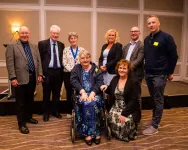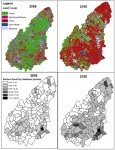(Press-News.org)
Cutting-edge cancer treatments like immunotherapy are offering new hope for patients, often in combination with more common approaches such as chemotherapy. But determining the best treatment combination isn't always straightforward. Many patients spend valuable time on expensive therapies with serious side effects that aren’t effective against their cancer.
Now, a new discovery is poised to help. Researchers from USC Norris Comprehensive Cancer Center have identified a biomarker that indicates which patients with non-small cell lung cancer (NSCLC) will respond well to chemoimmunotherapy. The biomarker, known as CX3CR1, is expressed on T-cells and can be detected with a simple blood test, six to nine weeks after a patient starts treatment. The results were published in the journal Cancer Research Communications.
"We found that T-cell CX3CR1 expression can be used to monitor treatment effectiveness, and can be used as a biomarker to predict treatment response and prognosis for these patients," said the study's lead author, Fumito Ito, MD, PhD, associate professor of surgery at the Keck School of Medicine of USC and co-leader of the Translational and Clinical Science Research program at the USC Norris cancer center.
Ito and his team collected a series of blood samples from 29 patients with NSCLC who received a combination of immune checkpoint inhibitor (ICI) therapy and chemotherapy. They found that patients with elevated levels of CX3CR1 after six and nine weeks of treatment were more likely to see long-terms benefits from chemoimmunotherapy, including tumor shrinkage and cancer remission.
The findings build on earlier work by Ito and his team, published in 2021, which found that CX3CR1 can be used to predict treatment response in NSCLC patients receiving immunotherapy only. The biomarker may also be useful for other cancers and therapies and could ultimately help doctors and patients determine the most effective cancer treatments while avoiding unnecessary side effects and invasive biopsies.
An "early-on" treatment biomarker
ICI therapy has revolutionized the treatment of lung and other cancers, but it doesn't work for all patients. For some, it can even trigger an autoimmune reaction marked by life-threatening problems with the lungs, liver, kidneys, or other organs.
Current pre-treatment methods to determine which patients will benefit from ICI therapy—and which will experience harmful side effects—don't always work. CX3CR1 is the next best thing: an "early-on" treatment biomarker that is noninvasive. It can be measured when patients attend their first check-up and imaging appointment, typically about two months after starting ICI.
"If ICI is not working, we like to stop as soon as possible," Ito said. "We have other viable treatment options for NSCLC patients, so the biomarker can help us identify patients who might have better results with an alternative therapy."
Ito and his colleagues used a multi-omics approach, combining two cutting-edge sequencing methods to find the genomic and transcriptomic signature of T-cells. Each T-cell has a unique receptor pattern that can be used as a “barcode” to track them down in different parts of the body, including those attacking a tumor and those circulating in the blood.
"By combining two different types of next-generation sequencing, we found a way to characterize and monitor patients' T-cells," he said. "Next, we plan to use this analysis in a larger cohort to see if patients with other cancers will respond in a similar way."
More evidence for CX3CR1
Because ICI therapy targets a patient's immune system, rather than the tumor itself, the newly discovered biomarker could have broad utility across multiple types of cancer. In addition to testing other cancers, Ito and his colleagues also plan to explore whether CX3CR1 can predict treatment response to other types of immunotherapy, including adoptive T-cell therapy and vaccine-based therapy.
The team will also collect additional evidence for CX3CR1 in a larger group of non-small cell lung cancer patients undergoing ICI, both with and without chemotherapy. If additional research is successful, a blood test for the biomarker could reach broader patient populations in two to three years, Ito said.
About this study
In addition to Ito, the study's other authors are Takayoshi Yamauchi from the Keck School of Medicine of USC; Eihab Abdelfatah from New York University Langone Health; and Mark D. Long, Ryutaro Kajihara and Takaaki Oba from the Roswell Park Comprehensive Cancer Center.
This work was supported by the Department of Defense Lung Cancer Research Program [LC180245], the National Cancer Institute [K08CA197966, R01CA255240-01A1, R01CA188900, R01CA267690, P30CA016056] and the Uehara Memorial Foundation.
END
CHAPEL HILL, NC -- Researchers at the UNC Gillings School of Global Public Health and UNC Lineberger Comprehensive Cancer Center found mailing human papillomavirus (HPV) self-collection tests and offering assistance to book in-clinic screening appointments to under-screened, low-income women improved cervical cancer screening nearly two-fold compared to scheduling assistance alone. Scheduling assistance primarily consisted of helping to book an appointment for in-person screening at a clinic, regardless of whether an at-home test was offered or returned, or whether the HPV test was negative or positive.
The findings from the randomized ...
Peer-reviewed / Randomised Controlled Trial / People
Clinical trial with 665 under-screened women in North Carolina (USA) investigated use of high-risk human papillomavirus (hrHPV) self-collection kits to increase cervical cancer screening uptake.
Screening uptake among participants sent self-collection kits and given support to attend an in-person appointment was almost double (72%) the cervical cancer screening uptake in those only given appointment support alone (37%).
More than three quarters (78%) of these underserved participants ...
At a recent event to celebrate the Association’s 85th Anniversary, the Association of British Paediatric Nurses awarded Honorary Fellowships to eight children’s nurses in recognition of their outstanding contribution to the nursing care of children and young people.
The 2023 Honorary Fellows
Ann Bisbrown Lee for services to children’s nursing and for many years’ service to the Association of British Paediatric Nurses, especially in leading marketing and conference activities.
Professor Steven Campbell for services to children’s nurse education and to the Association ...
Interventions aimed at reducing work-related stress for individual healthcare workers may lead to improvements in how people cope with stress up to a year later. Findings from a Cochrane review of the latest available evidence build on the conclusions of a previous review in 2015 that found low-quality evidence that interventions, such as cognitive behavioural training (CBT), mental and physical relaxation, were better than none.
The researchers included 117 studies of the effects of different interventions on stress alleviation in the current review, of which 89 studies were new. These 89 studies were published between 2013 and ...
New research has identified the month when people have the strongest suicidal thoughts, and that these thoughts occur a few months before the peak of suicide behaviours in spring/early summer. It also showed the daily peak in suicidal thought is between 4-5 am.
Most people assume suicide rates will be highest in winter, yet spring/early summer is when suicidal behaviours peak and this finding has baffled researchers since first identified.
Research from the University of Nottingham’s School of Psychology, led in collaboration with the University of Amsterdam and Harvard University, ...
Using artificial intelligence (AI) to process natural language, a research group evaluated the characteristics of speech among patients with Parkinson’s disease (PD). AI analysis of their data determined that these patients spoke using more verbs and fewer nouns and fillers. The study was led by Professor Masahisa Katsuno and Dr. Katsunori Yokoi, Nagoya University Graduate School of Medicine, in collaboration with Aichi Prefectural University and Toyohashi University of Technology. They published their results ...
A team of astronomers led by the University of Southampton have uncovered the largest cosmic explosion ever witnessed.
The explosion is more than ten times brighter than any known supernova (exploding star) and three times brighter than the brightest tidal disruption event, where a star falls into a supermassive black hole.
The explosion, known as AT2021lwx, has currently lasted over three years, compared to most supernovae which are only visibly bright for a few months. It took place nearly 8 billion light years away, when the universe was around 6 billion years old, and is still being detected by a network of telescopes.
The researchers believe that the explosion is ...
A previously unrecognised sedimentary archive in sand dunes could unlock a repository of fire records, a discovery that could expand fire histories across the globe.
The research, conducted by Dr Nicholas Patton during his PhD at The University of Queensland, has solved a persistent problem facing historians investigating changing fire patterns.
“Knowing how the frequency and intensity of wildfires has changed over time offers scientists a glimpse into Earth’s past landscapes, as well as an understanding of future climate change impacts,” Dr Patton said.
“To reconstruct fire records, researchers usually rely heavily ...
Could changing your diet play a role in slowing or even preventing the development of dementia? We’re one step closer to finding out, thanks to a new UNLV study that bolsters the long-suspected link between gut health and Alzheimer’s disease.
The analysis — led by a team of researchers with the Nevada Institute of Personalized Medicine (NIPM) at UNLV and published this spring in the Nature journal Scientific Reports — examined data from dozens of past studies into the belly-brain connection. The results? There’s a strong link between particular kinds of gut bacteria and Alzheimer’s disease.
Between 500 and 1,000 species of bacteria ...
AMHERST, Mass. – Researchers at the University of Massachusetts Amherst recently published a study in the journal PLOS Water that focuses on the Sudbury-Assabet and Concord watershed in eastern Massachusetts, and which links hydrological changes, including floods, drought and runoff, to changing patterns of land use.
“We all live in a watershed” says Timothy Randhir, professor of environmental conservation at UMass Amherst and the paper’s senior author. “We’re constantly modifying our landscape, turning what were once forests into ...






